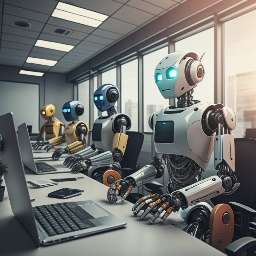Robots in the Workplace
 Unathi Okhue
Unathi Okhue
🤖💼 Robots are no longer just a thing of 🚀 science fiction. They are becoming increasingly 🏢 present in the workplace, helping to automate mundane tasks and revolutionize the way businesses operate. 🤔 But does this mean robots are a 💪 boon or a ☠️ bane? In this blog post, we will explore the 👍 pros and 👎 cons of having robots in the workplace and provide insight into how they can help or hinder productivity.
What are workplace robots?
🤖 Workplace robots, aka industrial robots or cobots, are programmable machines 🏭🤖. They perform tasks in various industries 🏭⚙️🏥🚚. From simple automation to advanced AI, they're versatile 🤯🌟. These robots enhance safety and efficiency by handling repetitive and hazardous tasks 💪🔒. They can work in extreme environments 🌊🚀. Some perform basic tasks, while others have advanced capabilities 🧩🧠. They boost productivity, cut costs 💼💰. Yet, there are ethical concerns we'll explore 🤔⚖️.
The benefits of workplace robots
In recent years, 🤖 have revolutionized workplaces, bringing numerous benefits:
⬆️ Productivity
Robots streamline production processes, boosting output speed, accuracy, and reducing errors, saving ⏰ and 💰.
👌 Quality
Robots ensure consistent, high-quality products, minimizing variations found in human work.
👷 Safety
Robots handle risky tasks in hazardous environments, reducing accidents and protecting workers' well-being.
💲 Cost Reduction
Despite initial expenses, robots require less maintenance, work non-stop and decrease downtime, leading to ⬇️ operating costs.
⚡ Efficiency and Flexibility
Robots work continuously, enhancing efficiency and enabling businesses to quickly adapt and scale production, gaining an edge over competitors.
Potential drawbacks of workplace robots
🤖Advantages of using robots in the workplace ✨:
Cost 💸
Robots can be expensive to buy and maintain, potentially posing challenges for smaller businesses. Hidden costs may arise during integration with existing systems and workflows.
Errors and malfunctions ⚠️
While robots boost productivity, they can also make mistakes leading to product recalls or worker injuries. Regular maintenance and repair procedures are crucial to minimize risks.
Threat to employment 👷♀️
Robots can replace human workers, especially in low-skilled jobs. This raises concerns about job security and automation.
Trust and transparency ❓
Despite advanced capabilities, uncertainty surrounds robots' decision-making. Biases and algorithm errors pose risks to businesses and customers. Overall, carefully weighing benefits and drawbacks is key before incorporating robots into workflows. Businesses must consider their needs to make informed decisions. ⚖️💼
The impact of robots on employment
🤖 The use of robots in the workplace is growing rapidly, raising questions about employment's future. Some argue robots will replace humans, causing mass unemployment 😱. Others believe robots will make jobs easier and more efficient, reshaping the workforce. 💼💪
💡 The impact of robots on employment is certain. Some jobs may vanish while new ones emerge with robotics advancements. What does this mean for workers? 🤔
👍 On one hand, robots boost productivity, making companies more efficient and profitable. This can create more job opportunities and safer work environments. 📈🛡️
👎 However, robots can replace human workers in certain industries, like manufacturing, leaving them jobless and financially unstable. 💔💸
🏥 The impact of robots varies by industry. In healthcare, robots may assist in surgeries and patient care, potentially creating demand for workers skilled in operating and maintaining these machines. ⚕️🤖
⚙️ The impact of robots on employment is not new. Technological advancements always reshape the workforce. However, with rapid robotics development, we must address potential impacts and prepare workers for change. 🔄💡
💬 The impact of robots on employment is still debated. Society must consider the implications of these advancements and strive for a future that benefits both humans and robots in the workplace. 🌍🤝
Examples of workplace robots
Robots in the workplace 🤖💼 are not new! They perform a variety of tasks in different industries:
Manufacturing Robots🏭⚙️
Welding, painting, packing - these precise and speedy robots boost productivity and efficiency.
Customer Service Robots🛍️🏨✈️
Assisting customers in retail, hotels, and airports by answering questions, giving directions, and booking rooms.
Medical Robots👩⚕️🤖
Used for complex surgeries, these advanced robots employ AI and machine learning for precise movements and accuracy.
Agricultural Robots🌾🤖
Harvesting, seeding, and weeding, these robots navigate difficult terrain and work tirelessly.
Cleaning Robots🧹🤖
Found in hotels, offices, and hospitals, these smart robots clean areas without human intervention. As tech advances, more innovative robots will shape the future of work! 🚀💼 #RobotsInTheWorkplace #Automation #Technology #FutureOfWork #AI #Industry40
Ethical considerations for using robots in the workplace
🤖💼 While robots in the workplace have benefits, ethical considerations arise ⚖️. As robots become more advanced, it's crucial to avoid violating ethical principles or harming employees. 🚫💔
One concern is robots replacing human workers, causing job losses and economic disruption. However, robots can also generate new jobs and opportunities. Employers should ensure fair distribution of automation's benefits, providing proper training and support. 👥💼🔄
Workplace safety is another concern, despite robots being designed for reliability. Employers must maintain and monitor robots diligently to prevent accidents, while training workers for safe operation. 🚧🔒
Privacy is important too. Advanced robots may collect sensitive data through sensors and cameras. Employers must use this data ethically, respecting workers' privacy rights and ensuring confidentiality. 🕵️🔐
Lastly, robots mustn't possess biases or engage in discriminatory behavior. Employers should program robots to be fair and unbiased, while monitoring for signs of discrimination. 👥✅🚫
Future implications of workplace robots
🤖 The use of workplace robots is growing, bringing more changes ahead. Key impacts include productivity, employment, and the economy. 📈
One major benefit of robots at work is higher productivity. 🏭 With robots handling repetitive tasks 24/7, companies can produce more goods and services at a faster rate. This boosts economic growth and efficiency across industries. 💪
However, increased robot use may lead to job displacement, especially where automation is prevalent. 🤷♂️ This can result in unemployment and inequality, making it harder for those without robot-compatible skills to find work. 😕
As robots become more advanced, demand for skilled workers to design, build, and maintain them will rise. 🛠️ This creates new job opportunities and increases the need for education and training programs. 📚
Of course, ethical considerations arise with workplace robots. ⚖️ We must address privacy, security, and accountability issues. Who's responsible if a robot harms a person or damages property? 🤔
Despite the challenges, robots will continue to play a crucial role in the workplace. 🌟 We'll witness advanced robots handling complex tasks and taking on more responsibilities. By anticipating and addressing implications, we can ensure robots benefit everyone. 👍
References
Pew Research Center. (n.d.). Automation and the Future of Work.
The Future of Employment: How susceptible are… | Oxford Martin School
Subscribe to my newsletter
Read articles from Unathi Okhue directly inside your inbox. Subscribe to the newsletter, and don't miss out.
Written by

Unathi Okhue
Unathi Okhue
I explore the boundless possibilities of expression